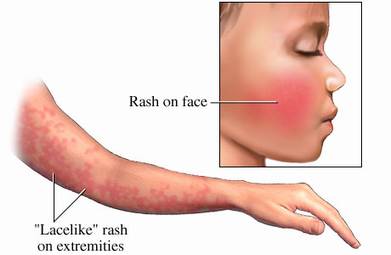
ERYTHEMA INFECTIOSUM - Fifth disease; "slapped cheek" disease; Academy rash
General Information: Erythema infectiosum is a common disease of school children characterized by a red rash on the cheeks followed by a lacy rash on the arms and legs. It usually causes very little illness although adolescents sometimes have mild joint pains or swelling.
Most adults who get Fifth disease develop just a mild pinkness of the cheeks or no rash at all. Adults develop joint pains, especially in the knees, more often than a rash. These pains may last 1 to
3 months.
For pregnant women exposed to Fifth disease, research has shown that 10% of fetuses who are infected with Fifth disease before birth develop severe anemia or may even die. This virus, however, doesn't cause any birth defects. Notify your obstetrician if you have been exposed to a child with Fifth disease during the contagious period. A blood test can be done to determine if you have antibodies against the disease.
The disease is caused by parvovirusB19. It is spread by direct contact with infected mucus from the nose or mouth or by inhaling droplets coughed or sneezed into the air. Illness starts from 4 to 18 days after exposure.
Because of the close and prolonged contact between students, epidemics of fifth disease are common in primary schools and academies.
The Illness: Fifth disease rash sometimes begins with no illness at all but usually starts with 3 or 4 days of low grade fever and symptoms of a mild cold. This is followed in 7 to 10 days by the appearance of a bright red, raised rash, which covers the cheeks, making them look as if they had been slapped. The area around the mouth is usually not involved.
After another 1 to 3 days a pink, blotchy and often itchy rash appears on the upper part of the arms and legs, spreading to the trunk and buttocks. As it fades, the rash develops a "lace-like" or "net-like" appearance, which can last for 5 to 10 days. Once cleared, it may reappear for several weeks or months if the skin becomes flushed from exercise, sunlight or a warm bath.
Young adults with parvovirus infection can have mild joint pains and swelling (arthritis), often without a rash. The hands, knees and wrists are most commonly affected. Discomfort lasts from a few days to several months. There is no permanent joint damage.
There are no complications from infection in a normal child. Children with blood problems such as sickle cell disease and those with certain cancers or on chemotherapy can develop severe anemia, usually without a rash. Infection in pregnant women can cause spontaneous abortion or anemia in the unborn baby.
Treatment: Most children with erythema infectiosum do not need medication or a change in diet.
Contagion: The disease remains contagious from 2 weeks to 3 days before appearance of the rash (or joint pains). Children usually feel perfectly well or have only a mild illness at this time and continue to play with other children. Thus, little can be done to stop the spread of this infection.
Children are no longer contagious and do not need to be excluded from school once the rash occurs.
Call your doctor about Fifth disease if:
The rash becomes itchy
Your child develops a fever over 101 degrees F (38.4 degrees C)
You feel your child is getting worse.
You have other questions or concerns.